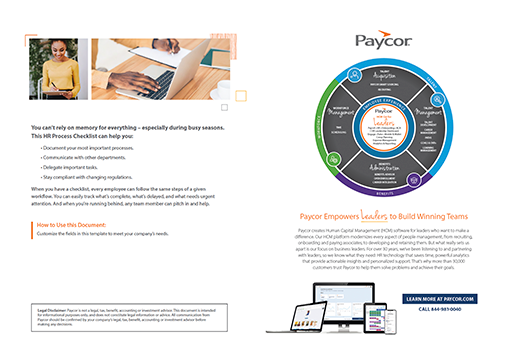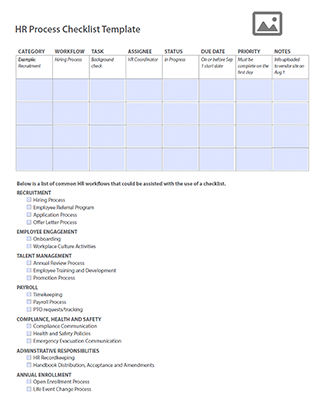Keep your team on track to meet important deadlines
When you work in HR, you’re always busy with something. You’ve got new hires to train, resignations to document, and don’t forget the constant compliance updates! There’s always a lot of pressure in this department. Your work is essential for the business. What feels routine for an HR professional could make or break the success of an entire organization.
If the sheer volume of work feels overwhelming, it might be time to update your systems. Fortunately, there are tools to make your life easier. For instance, using checklists can help you manage tasks, delegate work, and make processes more efficient.
Why HR Checklists Matter
If you’ve spent years in HR, you might feel like you already have a checklist in your head. Why waste time writing down what you already know? There are lots of answers to that question, but here’s a big one: checklists are scalable.
Over time – if all goes well – your company will grow. You’ll add more HR staff. You might get a bigger budget and invest in new technology. And through it all, your processes will have to change. A written checklist ensures that every employee can perform the same tasks consistently. This reduces the mental load HR leaders carry. It also gives your whole team more flexibility. If you’re out sick, your employees still have to get paid. Why not document the process so your team can keep things moving while you’re gone?
Checklists also streamline communications with other departments. It can be hard for other people to understand what goes on in HR. Clear documentation helps you clarify deadlines, keeping managers on schedule. It also sets expectations with your colleagues. For example, a hiring manager might want a new hire to start immediately without knowing much about your onboarding process.
Perhaps most importantly, HR checklists help you stay compliant. They’ll remind you when to submit certain forms, how to prepare for audits, and which employment laws you need to check for annual updates. Your checklists can even track when you complete certain steps, in case you need those dates for reference.
Setting Up an HR Department Checklist
As you start to build a checklist, think about the end goal. That should help you decide on a format. For example, how will your team use this checklist? Is it a linear process where one item needs to happen before the next? Or is it a list of things that can happen in any order? Either way, your answer could change the way you organize the document.
Next, brainstorm every single item that should go on the checklist. It’s ok to take your time. If possible, work with your team to do a “brain dump” of related tasks. You can always edit this list later – it’s easier to cut information than to add it.
After this exercise, it’s time to buckle down and create the checklist itself. Use these tips to get started:
- Break down your checklist into sections. If your team is big enough, you can assign different sections to different people, and then go through a review process together.
- Split up large projects into smaller component tasks. Be sure to include as much detail as possible. For example, if part of the hiring process is having your new employee read and sign certain forms, make each document an item on the checklist.
- Note all important dates and deadlines and include time-bound tasks in order.
- If possible, include details about how long each task should take. For example, it might take up to three days to complete a pre-employment screening. Put time-consuming tasks higher up on the checklist to keep them moving while you work on other things.
- Add the department, job title, and person responsible for each task when you can. These could be internal contacts, like your company’s CFO, or external contacts, like your workers’ comp insurance
This checklist should be as comprehensive as possible, including every HR task. However, it should also be a living document. Use secure HR software to update it regularly, make it accessible to everyone who needs it, and keep it safe from prying eyes.
What Goes on an HR Checklist
Your checklist should outline key HR processes, including but not limited to:
- Hiring process (requesting a new hire, writing job descriptions, screening candidates, etc.)
- Onboarding process
- Running employee engagement surveys
- Offboarding and exit interview processes
- Annual benefits enrollment
- Timesheet setup
- Payroll processes
- Performance reviews
- Corporate travel approval
- Travel reimbursement
- Ongoing employee training
- Workplace culture activities
- Annual salary increases or bonuses
- Conflict resolution procedures
- PTO and leave management
- Communicating policy updates (updating the employee handbook, hanging labor law posters)
- Annual compliance reviews (updating minimum wage requirements, workers’ comp insurance audits, etc.)
- Safety protocols
This list could be a lot longer depending on your company size, industry, and so on. Make sure you have key HR stakeholders review your final draft before you share it widely.
Sample Checklist Template
When you’re ready to build an HR checklist, download Paycor’s free template. Use our format as a starting point, and customize each field to meet your team’s needs.











